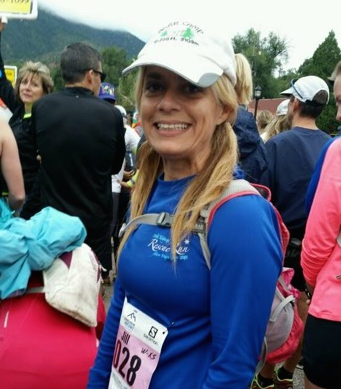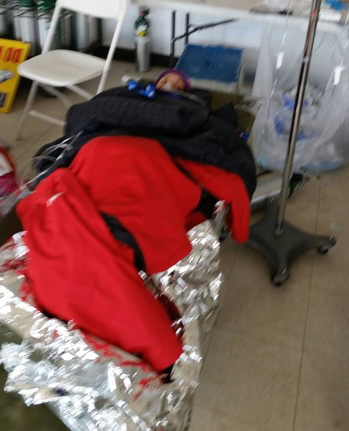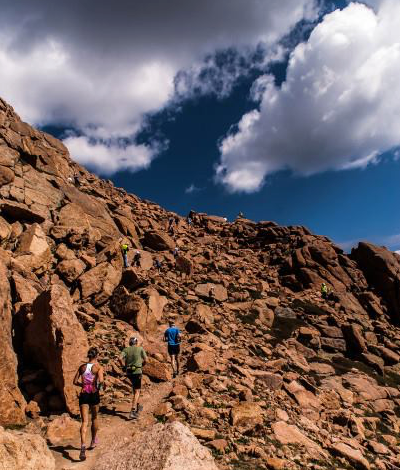"Help, I need help," I cried as I felt my legs give out. I wanted to throw up. I was so thirsty, so muddled and confused that I'd forgotten to drink the water in my pack.
But I'd made it nearly eight thousand feet to finish the thirteen-mile Pikes Peak Ascent. I crumpled into a race volunteer at the summit finish line, who guided me to a low outbuilding typically used for storage and snowcats. It had been turned into a makeshift hospital, a MASH unit at 14,115 feet.
By the time I'd reached the two-mile-to-go sign, I'd tried to repeat to myself a mantra coined by Matt Carpenter, who has set records on Pikes Peak and at the Leadville 100 Trail Run: "Think to yourself JAM: Just Always Move. If that means running, awesome. If that means walking, super. If that means crawling, do it." But my fuzzy brain didn't seem capable of thinking straight.
Too proud and stupid to ask Search and Rescue, stationed all over the mountain, for help, I somehow made it to the finish line at the top on my own. I had seen many runners keel over at the finish over the years, even throwing up and passing out, assisted by Search and Rescue and medical personnel. But I had never been that person. Until now.
Advertisement

As a nurse and member of the rescue team helped me to a cot, I lay back, shivering. Later, I was told that my lips had been blue, my face white. I was wrapped in blankets, given an oxygen mask; an IV was stuck in my arm.I had been running on the mountain consistently for practically a year, often in sub-twenty-degree temperatures and often going to nine or ten thousand feet in elevation, the spikes in my shoes stabilizing me as I ran on ice and snow for hours at a time. This was my ninth race on this mountain. Yet none of the training was paying off as it had in the past.I had been hit by acute mountain sickness (AMS), an illness at altitude that can include a spectrum of symptoms, including headache, fatigue, nausea and/or vomiting, dizziness, and difficulty sleeping at altitude. Acute mountain sickness has two more extreme forms. The first, High-Altitude Pulmonary Edema (HAPE) occurs in response to a shortage of oxygen at higher altitudes, resulting in lung vessels weakening and eventually rupturing as a result of the pressure. This can cause a dangerous buildup of fluid. Symptoms of HAPE include extreme fatigue, breathlessness at rest, and coughing up blood.

HAPE can lead to High-Altitude Cerebral Edema (HACE), in which the brain accumulates extra fluid, swells and stops working properly. An increase in blood flow is a normal response to low oxygen levels at higher altitudes, as the body needs to maintain a constant supply of oxygen to the brain. However, if the blood vessels in the brain are damaged, fluid may leak out and result in HACE. Confusion, altered mental state, fever, and loss of consciousness can result. HAPE and HACE are treatable if diagnosed quickly, but they can be deadly if not.
Advertisement
Despite the relatively common occurrence of acute mountain sickness, as anyone who has flown into Colorado or Utah from the lowlands to ski at resorts from Copper Mountain (12,313 feet), Crested Butte (12,170 feet), or Alta (10,550 feet), can attest, mild headaches and sleep disturbances usually disappear with acclimation, good hydration, and rest. But the more serious forms of HAPE and HACE, while not rare in the high country, can be avoided with awareness and getting prompt medical care if these symptoms persist.Though science has been as yet unable to entirely predict who will get acute mountain sickness, high-altitude emergency physicians, many of whom are climbers and skiers themselves, do agree on three crucial facts: First, that is a spectrum illness that can pick up steam quickly; second, that it is unpredictable, striking both the super-fit and the casual weekend warrior, and third, that it is strongly correlated to a rapid increase in altitude."Like most things in medicine, there's a variability and a spectrum of how sick someone can be," says Tim Hurtado, medical director of the El Paso County Search and Rescue team, who provide medical support for the Pikes Peak races. "Most people coming to altitude can have a little bit of a headache and not sleep well at first. Then you acclimate. But in some cases, you can skip right over acute mountain sickness. So what starts as a little bit of a headache, in an hour or two and a few more hundred feet of vertical gain, can turn into pulmonary edema."
Advertisement
Hurtado says that cerebral and pulmonary edema are more common at extremes of altitude, as in Colorado's Summit County, which straddles the Continental Divide, and is home to ski resorts like Breckenridge, Copper Mountain, Arapahoe Basin, Loveland, and Keystone."If you're flying in from say, Florida or Texas, to ski for vacation, you land in Denver, rent a car, drive to Summit County, jump on the mountain, and take a lift all the way to the top of Breck or Copper. And since you're above timberline at 12,000 feet, almost universally you're going to get some form of acute mountain sickness. And if you don't come down quickly, you can develop a bit of high-altitude pulmonary edema."Hurtado adds that getting to your mountain destination can bring on a cold—something that normally wouldn't slow you down. "But a little respiratory infection and increasing altitude can put you at an increased risk."

Lake Tahoe-based climber Lara Miller knows this well. As an experienced climber who had done trips to the Himalayas before, she was rescued by helicopter at 17,000 feet last April as she and her climbing partner tried to reach the 22,349 ft. summit of Ama Dablam."I almost died up there," she says of the high-altitude pulmonary edema that struck her unexpectedly, after acclimatizing over a few days' time. "It started with a cold and not feeling so good one morning," she says. "So I popped some cold medicine." Later that day, Miller was weak, woozy, and scared. "I told my climbing partner to go on, that I would return to base camp." Coughing up blood, she says she could hear herself breathe as she lay down to rest, her brain a scramble of what to do.
Advertisement
"My climbing partner knew I needed a helicopter out, even though I kept saying I was okay," she says. "I wasn't even walking in a straight line. "Luckily, I had dex (dexamethasone) in my emergency kit, what climbers are required to carry in Nepal. It's a strong steroid that immediately clears the fluid out of your lungs. That and getting off the mountain when I did saved my life. What was crazy was that the day before, I would have never predicted I would have gotten so sick.""This is why it's so important to not climb alone," says Jeffrey Gertsch, a clinical neurologist at the University of California, San Diego, and a climber who has had HACE himself. "You need someone to look at you and recognize when you're doing something crazy—your brain isn't working right, so by definition, you're in a state of delirium."Gertsch spent six months at Everest base camp conducting experiments on susceptibility to acute mountain sickness. Like Search and Rescue's Tim Hurtado, he agrees that fitness has very little to do with it. "That's the beginning of what gets a lot of people into trouble," he says. "They think, 'well, if I'm really fit, than I'll do okay.' They think if you're sucking wind, which is what it looks like if you have altitude sickness, then obviously you're just out of shape. But that's not true."Instead, he says that it's a combination of factors that can help researchers determine how someone might be affected, including genetics and development (i.e. if someone grew up at altitude), as well as acute factors, including fitness level, dehydration, whether or not you have a low-level virus or are low on sleep, or high in stress. I had felt tired and under the weather the week before the Pikes Peak Ascent and wasn't sleeping well.
Advertisement
"Altitude illness is a very opportunistic situation and will jump on the back of any illness of any kind," adds Gertsch. "Anything that will break homeostasis will tip the balance between adaptation and disease at altitude. It's a balance."There is another risk factor for AMS I knew about and had conveniently forgot, namely, that having acute mountain sickness once puts you at risk for getting it again. After finishing the 2009 Pikes Peak Ascent, I told Search and Rescue that "really, I was fine," when a few team members asked if I was okay at the summit.But I was most definitely not. That night, after a delirious drive home, I was in the emergency room hooked to an IV. The diagnosis: acute mountain sickness and severe dehydration.It's obviously hard to convince high-altitude runners, climbers, and other endurance athletes that downplaying how bad they feel—or worse—actually stopping—is not only in their best interest but could in extreme situations save their lives. Search and Rescue's Tim Hurtado says that even though they might not truly believe it, the fittest runners, climbers, and skiers can get acute mountain sickness. Furthermore, the same athlete who is fine at 14,000 feet on one climb might find herself ravaged by HACE at 11,000 feet on her next climb."We see plenty of people who are super-fit, healthy, and young, who are amazing athletes, who get acute mountain sickness with no antecedent warning," he says. "And then there are other people who might be the biggest couch potatoes and they climb like there's no tomorrow. We do know that young people tend to be more at risk. They tend to push themselves harder and climb faster, and they don't give their bodies a chance to acclimate. But that's not one hundred percent—there are a lot of young people who climb with no problem. We just don't understand why someone who might be on top of a 25,000 foot peak with no problem comes down to a smaller peak and gets sick."
Advertisement
Though there is no one predictor of who will come down with acute mountain sickness, physicians and rescue teams are sure what to do to treat it: decrease altitude. "The best treatment for all acute mountain sickness is descent," says Hurtado. People will feel a lot better with even a thousand feet of vertical loss."And there are many things you can do to decrease your chances of getting sick at altitude, including acclimating slowly, staying hydrated, particularly in dry mountain climates, getting plenty of sleep, and listening to your body. Of course, this is easier said than done."One of the problems we see from a medical standpoint is that the type of person who gets into trouble is not the kind of person who's going to stop," says Ira Hoffman, retired chief of medicine at Lenox Hill Hospital in New York, who has himself had bouts of altitude sickness in Tibet—and no problem in Colorado.But stop we must."You've had your body a long time, is what I tell a lot of my patients," Hurtado says. "So you need to listen to it. As an athlete, you know when you're on and when you're off. And if you're having an off day, you're not going to get better as you go higher. And the mountain is not going anywhere. It will still be there next year."
